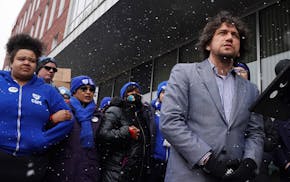How far is it from Minneapolis' Seven Corners to the West Bank? 280 feet. 40 years. And a long series of opportunities.
Plans for locating light rail service and a station area in the Washington Avenue trench have focused attention on the long-deferred challenge of reconnecting Cedar-Riverside and the West Bank to Seven Corners and downtown Minneapolis. In its current state, Washington Avenue cuts a barren path through land located between two of Minnesota's most productive places – downtown Minneapolis and the University of Minnesota.
Washington Avenue currently serves as a highway, moving cars and trucks back and forth from downtown and the University's West Bank, across the river to its East Bank. By a rough estimation, there appear to be over six acres of vacant right of way between I-35W and the edge of the University's campus marked by the 19th Avenue bridge. The space has been, in the words of one observer, "mothballed for decades" – at least since the late 1960s when the current road design was constructed. It's an underutilization of space that's highly valuable (in dollar terms and otherwise), thanks to its proximity to downtown Minneapolis and the University, and its access to existing infrastructure.
Mic Johnson, an architect with Minneapolis-based firm Ellerbe Becket and adjunct professor at the University, has led graduate students of architecture in an exercise that conveys the remarkable opportunity for redevelopment along the Washington Avenue trench. Given the disruption that LRT construction will prompt, now is the time to plan for reassembly of the West Bank, creating a more connected place while boosting its economics and tax base.
"We focused on that land because we knew that LRT was coming in, we knew there was a real disconnect between Seven Corners and Cedar-Riverside," Johnson said last week. "You can look at the history of that place and see its transformation over the last forty or fifty years from a really cohesive neighborhood into something that had a huge gash running through the middle of it. So…what would be the transformation that might take place if you really reengaged the street?"
Using a back-of-the-envelope estimate with modest assumptions, redeveloping the six vacant acres adjacent to Washington Avenue with buildings averaging just two floors would add over $40 million of property value to the area. With average building height of three floors, the added property value is $60 million. Much higher buildings are certainly feasible given the change in grade and (as the image suggests) could be developed in an unobtrusive way around the LRT station, in conjunction with green spaces to further enhance the quality of the space and surrounding values.
In a place such as the trench, most if not all basic infrastructure is already in place, making redevelopment notably cost-effective. Unless the route is altered yet, the LRT station planned for the West Bank represents an opportunity to focus redevelopment in the immediate area, maximizing the return on the public investment there. Drawing Seven Corners and the West Bank closer together would link places from the Mill District to Cedar-Riverside in a potent way, providing a street connection to areas that stretch over two miles of Mississippi riverfront.
There are many people and organizations who have been long engaged in planning for the future of these neighborhoods, and consensus about next steps is still emerging. And the notion of redeveloping the vacant space along the Washington Avenue trench has been discussed before. The idea of narrowing the trench, using the contiguous space in a more constructive way, deserves to go beyond discussion in the short time to come before LRT service commences.
Image: Used with permission of Mic Johnson, University of Minnesota, School of Architecture, College of Design.

U of M's interim president meets with pro-Palestinian protest leaders

Legendary boys hockey coach Randolph loses his job

Minneapolis education support professionals file intent to strike

Thou shalt not blend church and state, new Minnesota jail is told

